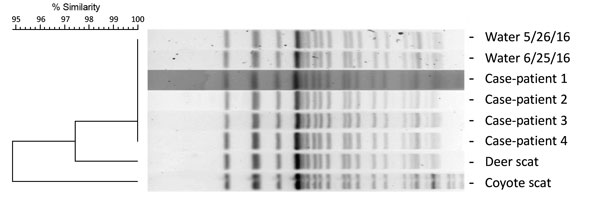Volume 23, Number 7—July 2017
Research Letter
Contaminated Stream Water as Source for Escherichia coli O157 Illness in Children
Figure

Figure. Pulsed-field gel electrophoresis (PFGE) analysis of Shiga toxin 1– and 2–producing Escherichia coli O157 isolates digested with XbaI. A dendrogram displaying PFGE pattern similarity is shown at left. The PFGE profiles for the case-patients and water isolates were identical and designated as pattern EXH01.0238 by PulseNet (https://www.cdc.gov/pulsenet/). The PFGE patterns for the deer and coyote scat isolates shared >95% similarity with pattern EXH01.0238. Dates on water samples indicate date of collection.
Page created: June 19, 2017
Page updated: June 19, 2017
Page reviewed: June 19, 2017
The conclusions, findings, and opinions expressed by authors contributing to this journal do not necessarily reflect the official position of the U.S. Department of Health and Human Services, the Public Health Service, the Centers for Disease Control and Prevention, or the authors' affiliated institutions. Use of trade names is for identification only and does not imply endorsement by any of the groups named above.